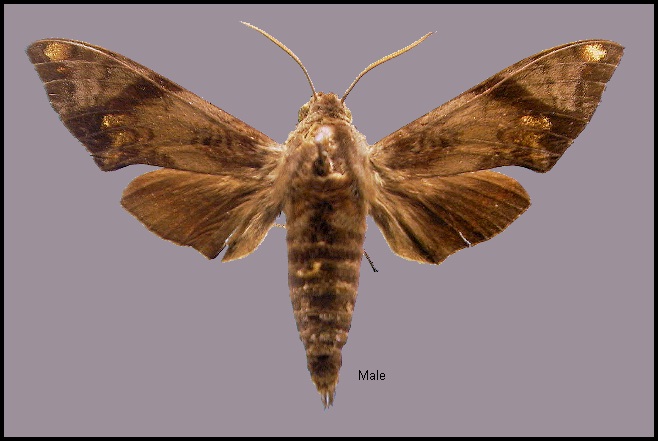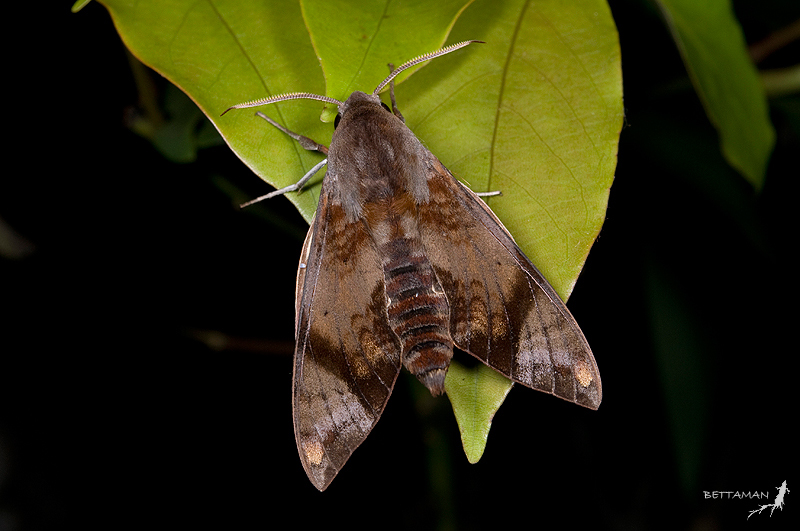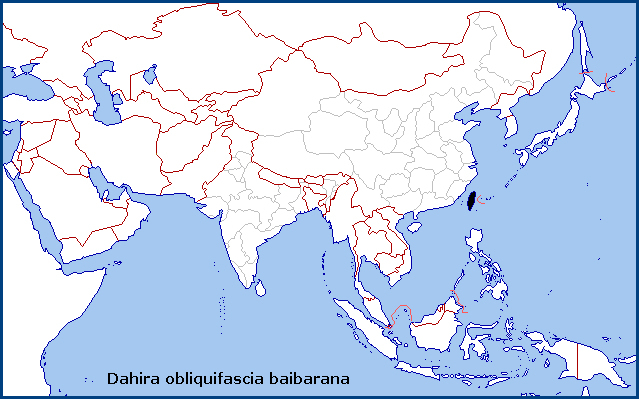
Ampelophaga baibarana Matsumura, 1927, J. Coll. Agric. Hokkaido Imp. Univ. 19: 3. Type locality: [Taiwan, Nantou Hsien, Meiyuan,] Baibara.
Note. According to Haxaire, Melichar & Manjunatha (2021), this species has an incredible level of variation in the male genital armature, in particular in the shape of the apical processes of the phallus and harpe. However, unlike in Dahira rubiginosa, the variation in Dahira obliquifascia 'seems' to follow a biogeographical logic, although it must be used with extreme care, and in its entirety. In addition, DNA barcode analysis shows clear separation of the populations from Taiwan, southeast China, northeast India and mainland South East Asia. As in Dahira rubiginosa, Haxaire, Melichar & Manjunatha (2021) accept that this separation makes biogeographical sense and treat these four groups as subspecies. Names for two already existed in the synonymy, and these were revalidated. They describe a third, South East Asian subspecies, as new, namely Dahira obliquifascia siamensis Melichar & Haxaire, 2021. In this taxon, all specimens from South East Asia that Haxaire, Melichar & Manjunatha (2021) examined have the apical plate of the end of the phallus more flattened and more strongly serrated, compared with the nominotypical Indian population. Also, there is, on average, a 2% divergence in their DNA barcodes from Dahira obliquifascia obliquifascia and Dahira obliquifascia huangshana. The adult moths are statistically larger and more slender than the moths from southeastern China. Their coloration is more shimmering, but without reaching the level of contrast of the moths of northern India.
Note. The Taiwanese population, characterized by smaller and strongly darkened individuals, was described by Matsumura from a specimen collected at Baibara [Meiyuan] on 22 April 1926. The subspecies was synonymized with Ampelophaga obliquifascia by Clark (1932), then reinstated as a subspecies by Haxaire (1994), before being resynonymized with the nominotypical subspecies by Brechlin (2000). On the basis of the results of DNA barcode analysis, Haxaire, Melichar & Manjunatha (2021) reinstated it as a good subspecies of Dahira obliquifascia.
Wingspan: 70mm. Forewing upperside purplish-grey, tinged in parts with reddish-brown; subbasal diffuse reddish-brown marks in cell and on 2A+3A; three rather indistinct, diffuse, waved, antemedian brown lines; a small discoidal dot; a broad blackish-brown band from middle of costa to outer margin at M3, expanding into a large triangular patch on outer margin extending almost to tornus; a postmedian line slightly dentate from costa to the blackish-brown band, then oblique and more strongly dentate, with some fulvous-yellow on its outer side, a waved line before it from Cu2 to inner margin and two waved lines beyond it from the band to the inner margin; a double brownish, slightly waved submarginal line from costa to M2; a wedge-shaped brown mark on outer margin below apex; cilia blackish-brown. Hindwing dark brown tinged with red, the inner area greyish; cilia rufous, whitish at tips. Underside: breast orange-red; forewing fiery-red, with the outer margin grey, some dark brown suffusion in and below cell; six indistinct waved lines in postmedian area; a pale yellow subapical lunule and two wedge-shaped postmedian marks below Cu1 and Cu2; hindwing fiery-red, the inner area greyish, marginal area brownish; three indistinct, minutely waved, red postmedian lines. Head and thorax grey slightly mixed with reddish-brown, vertex of head and dorsum of thorax reddish-brown; abdomen grey, with broad dorsal, diffuse, reddish-brown bands.

Not rare at altitudes between 500m and 1000m.
Taiwan: 26.iii.2014 (Taipei City); iv-v (Kaohsiung Hsien).
OVUM: Unknown.
LARVA: Unknown.
PUPA: Unknown.
Larval hostplants. Unknown.
Unknown.
Taiwan: Taichung Hsien (Meiyuan); Kaohsiung Hsien (Shanping, 640m; Fujizhi Forest Road, 1477m); Taipei City (Sindian; Beitou District); Taipei Hsien (Fushan); Taoyuan Hsien (Xicun, 1090m; Ming Chyr Forest Recreation Area, 1160m); Nantou Hsien (Wushe; Huisun Forest, 21km N Puli, 950m; Aowanda National Forest Recreation Area); Pingtung Hsien (10km E Mudan, 400m); Yilan Hsien (Fushan Botanical Garden).
Confined to Taiwan.
[Dahira obliquifascia obliquifascia (Hampson, 1910) occurs in Nepal, northeast India (Meghalaya, Arunachal Pradesh and Mizoram), and just into Xizang/Tibet, China. Dahira obliquifascia siamensis Melichar & Haxaire, 2021, occurs in Burma/Myanmar, Laos, Thailand, Vietnam (Le & Vu, 2024) and Peninsular Malaysia, and just into Yunnan, China (Menglian County, Kabieke Shan; Menghai County, Xishuangbanna). Dahira obliquifascia huangshana (Meng, 1982) occurs across southeasten mainland China (Haxaire, Melichar & Manjunatha, 2021).]

 Return to Sphingidae of the Eastern Palaearctic species list
Return to Sphingidae of the Eastern Palaearctic species list